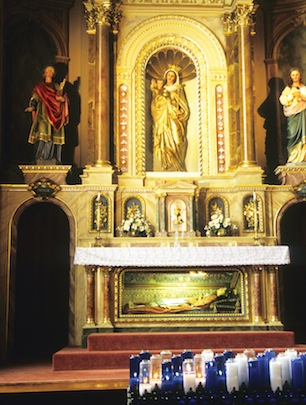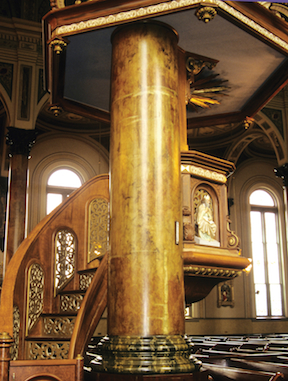
THE SHRINE OF ST. JOSEPH

The church’s cornerstone was laid in 1844, and the building initially had its main door facing west onto 11th Street. The church wasn’t truly completed until 1866 after the Civil War when the main entrance was changed to face south.
It was a church established for the German population by Bishop Peter Kenrick. Germans came to St. Louis in large numbers throughout the middle part of the 19th century. It is said that only Germans could satisfy their Sunday Mass and other religious obligations here. Other ethnic groups had their own parishes.
From its early days, St. Joseph’s was the home of a sacred relic—a bone chip from the body of St. Peter Claver, who was known for his service to slaves.
The only miracle in St. Louis to be authenticated by the Vatican happened in this church. Ignatius Strecker was a German immigrant with nine children who worked in a local soap factory. In 1861 Strecker hit his chest against a piece of iron. The injury didn’t seem serious, but a tumor-like inflammation began to grow over the following months. A doctor opened the wound and found that the breastbone and ribs on the left side were decomposing and there were also signs of tuberculosis. Mr. Strecker found it difficult to breathe or to eat and eventually had to give up his job. One of the most noted physicians of the time, Dr. William Schoenemann, examined Strecker and told the family the man had just two weeks to live. But Strecker hung on, although he prepared for death.
A Jesuit missionary, Father Francis Xavier Weninger, came to St. Joseph’s and gave a sermon on Blessed Peter Claver (he had not yet been canonized a saint). He blessed the assembled with the relic. Mrs. Strecker was among them and went home to urge her husband to invoke Claver’s help. Strecker was carried into the church where he was blessed by Father Weninger and allowed to kiss the relic. Strecker related later that immediately his wounds started to heal. The tuberculosis vanished. The day after the blessing Strecker returned to work and he lived until 1880. The miracle was one of the two that led to Claver’s canonization in 1888.
The city of St. Louis, like many others, was hit with major cholera epidemics throughout the 1800s. The worst was in 1866 when St. Joseph’s would be the site of 10-25 funerals a day. Pastor Joseph Weber talked with his parishioners one Sunday morning and asked them to make a vow to God. If St. Joseph would intercede on their behalf and spare the parish from more cholera deaths, they would build a monument in thanksgiving.
An initial pledge of $4,000 was made by the families and, amazingly, St. Joseph’s parish experienced no further deaths. The vow was kept, and the magnificent Altar of Answered Prayers was built to become the focal point of St. Joseph’s. It cost $6,100 in 1867. Today it is priceless.
St. Joseph’s expanded again in 1881 when the twin towers that became the signature of the church’s imposing façade were added. A new pulpit was installed in 1894 that features the figures of Saints Augustine, Jerome, Leo and Ambrose, doctors of the church.

As time passed, the neighborhood around St. Joseph’s began to change. Italians moved in in the early 1900s, but they had their own parish close by. By the 1960s, the area had become more industrial. People moved out, truck terminals moved in. The beautiful church of St. Joseph’s deteriorated along with its surroundings. Attendance at Sunday Mass dropped to the point where it was said that there were more pigeons there than people. The wooden statues had dried and cracked. The organ was in pitiful shape. St. Joseph’s was dying.
However, six men would see to it that that didn’t happen. Perhaps the most important of the six was a priest, Father Edward Filipiak. He was in his late-70s and frail, living in one small room in St. Joseph’s rectory. Connected to the church behind the altar, the rectory had become unfit for animals to inhabit, much less a priest. But Father Filipiak loved his church. He saw the beauty that still was there and said “I ain’t movin’.” He knew that if he left, St. Joseph’s would be torn down.
In the late 1970s, Father Filipiak brought five visionaries together. Bob Arteaga (the man who photographed the building of the Gateway Arch), Eugene Boll, Charles Finninger, Charlie Heisler and Bob Voss had not known each other before, but each saw something in St. Joseph’s that made them want to save it. They established a not-for-profit corporation in 1978, leasing the church from the St. Louis Archdiocese for $1 a year.
Raising the money to restore the church would be difficult. The catalyst that would make this happen came about in the most tragic way imaginable. On September 29, 1979, three teenagers from the neighborhood broke into the rectory and brutally murdered Father Filipiak. The attention focused on Father’s murder and the church he loved helped to inspire a city to make his final wish a reality.
Maintaining the Shrine of St. Joseph is still a struggle—nearly $5 million has been raised and spent on the church’s rebirth in the past 25 years. The resources have come from many places, some of them unexpected. Contractors have given in-kind services. A Jewish man who grew up in the tenements nearby donated $100,000 as a way of giving back to the neighborhood.
The work was almost unimaginable. Over 100,000 pounds of bird droppings were removed from the bell tower. Many of the wooden statues were in desperate shape and had to be painstakingly restored. Restoration of the pipe organ, made by Johann Pheffer and Sons of south St. Louis and installed in 1890, took 18 months and cost $197,000. Church organist Ralph Ellerbrock was pleased to have the organ back in working order. He has been serving St. Joseph as organist, choir director and tour guide for 60 years.
For all who have been involved in this restoration work it has truly been a labor of love. There is something about St. Joseph’s that seems to “get under people’s skin,” as Ralph Kannady put it. He and his wife went to mass there one Sunday about 22 years ago and have been back almost every Sunday since. Both are active volunteers in the church.
Kathie Schmid and her daughter were searching for the right place for the daughter’s wedding about four years ago.
“When we walked into St. Joseph’s we all had goosebumps and knew this was the place,” the mother explains. For the last three years Kathie, too, has been a volunteer here. Fittingly, she helps with wedding planning.
The statues are certainly a prominent part of the Shrine, and they are there in greater numbers than in most churches. The members of the Holy Family, evangelists, Jesuit saints and other prominent figures in Catholic history can be found throughout the Shrine. A wooden replica of the Pieta is featured in the rear of the church.
It is a beautiful place that inspires people to return again and again. It is where miracles can come true if one believes strongly enough. The men and women who rebuilt the Shrine of St. Joseph believed, and the proof is in this St. Louis treasure.
The Shrine of St. Joseph is located on the corner of 11th and Biddle, just a few blocks north of America’s Centre. Sunday Mass is at 11 a.m. A tour of the church and rectory are offered after mass. For more information, call 314-231-9407 or visit www.shrineofstjoseph.org.
